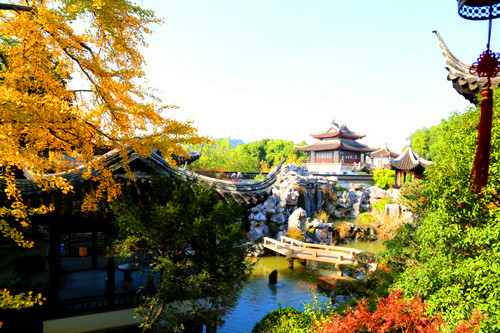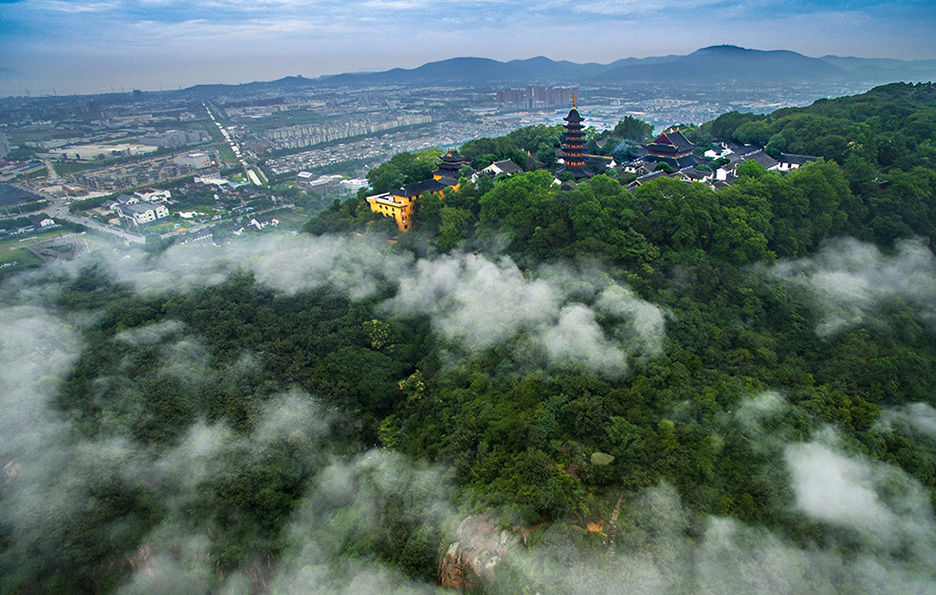
Pinus sylvestris (botany)
Fifty paces east of Lufei Bridge on Shantang Street, there is the Ancient Pine Garden. Its architectural layout for the front of the house after the garden, typical of the Qing Dynasty mansion garden style. All the buildings in the house are simple and elegant, and the carvings are very fine, which have certain artistic and cultural value, and are the cultural relics protection units of Suzhou. There is a Ming Dynasty Luohan Pine in the back garden, which is verdant and gnarled, with a beautiful posture, and the Ancient Pine Garden is named after this pine.
Ancient Pine Garden was built by Cai Shaoyu, a rich man in Mudu at the end of Qing Dynasty. Cai Shaoyu's ancestry is from Dongting Xishan, originally doing foreign goods business in Shanghai, and then returned to his hometown to build a house and land, with ten thousand hectares of good land. Cai Shaoyu and Yan Guoxin (Yan Jiajian's grandfather), Zheng Lingjiu, Xu Fenglou three families together called Mudu "four rich men", rich.

Passing through the entrance hall, entering the patio, looking back, you can see the brick-carved doorway. Doorway on the upper and lower square were engraved with "Laozi westward journey into the customs", "crazy monk sweeping Qin", "generals and", "cut off the river to take the fight "," Zhang Yu passes the book "," Ning Qi rice cow "and other historical stories. The word square is "Mingde Weixin", the two sides of the pocket were "Zhang Liang picking up Crawler" and "high mountains and flowing water", the whole doorway deep carving decoration, the shape of God, especially the "Zhang Liang picking up Crawler". The arch bridge in "Zhang Liang picks up the footsteps" and the water wave ripples in "High Mountains and Flowing Water" are vivid and lifelike with strong texture, fully reflecting the subtlety of the carving technique.
The hall, named Ancient Pine Hall, is modeled after the Ming architectural structure, with four pairs of hawsers on each of the beams of the Buxuan and the inner four boundaries, which are shaped like the two wings of an ancient official's hat, and is commonly known as the Hall of Hats. The four pairs of rows of wood in Buxuan are smaller, respectively carved with Lv Chunyang's sword, Tie Qiao Li's gourd, Cao Guoyu's sandalwood board, Han Xiangzi's bamboo flute, and Lan Caihe's flower basket, etc., which is known as the "Eight Immortals of Darkness" in the folklore. Beam head of the mountain mist cloud and hold the beam cloud for the "crane nine gao", vivid, subtle. The most interesting is the beam frame in the middle of a square rafter engraved with eight pipa, called "eight sounds of joy", meaning joyful celebration. It is derived from "Yao Dian", "Eight Tones of Harmony", and there is also a song of "Eight Tones of Harmony" in the opening of Suzhou Playing Ceremony, which is played with eight pipas. The eight pipas are carved into the rafters, and there is no other example of such usage in Suzhou garden architecture.

Ancient Pine Garden's hall is the most distinctive, because the lower end of the eaves square is carved with sixteen inverted flower baskets, and sixteen phoenixes are carved on the upper floor beams, some people call this hall "flower basket building" or "phoenix building". Phoenix floor carving master is the late Qing Dynasty and early Republic of Suzhou famous carving artist Zhao Zikang. Zhao Nai Mudu town Phoenix village people, the most famous work is the Dongshan carving building, Mudu Phoenix building is its early works, so some people call these two buildings for the "north and south sister carving building". All carvings on the phoenix building are auspicious patterns, folk known as the "mouth to discuss color". Such as the bright gable square from west to east were engraved with paintings, books, letters, treasure, known as the "book has its own golden house". The second gable square engraved with flower baskets, flutes, swords, gourds and other "dark eight immortals". Room gable square engraved with conch, fire wheel, coral, copper drum and other eight treasures, known as the "eight treasures". Hanging down the eaves for the entanglement of flowers, plums, lotus, chrysanthemums, camellias and other seasonal flowers placed in a vase, known as the "four seasons of peace". Downstairs room window pane carved with plum, orchid, bamboo, chrysanthemum "Four Gentlemen", symbolizing purity of character. Window railings carved with lions and elephants, the former symbolizes authority, the latter represents the renewal of all things. Downstairs in the Xuan Gallery of each lotus beam are carved with a pair of elephants, said "good luck". Upstairs balustrade for the ring pattern, the center vase inserted three halberds, harmonic "flat rise three levels" sound. Eaves hanging down the corner of the bat pattern, bat "change the blessing" resonance.
Into the garden can be seen a luohan pine, more than ten meters high, for the Ming Dynasty relics, according to "Wu County" records, the tree has been more than five hundred years old. From the appearance, it is still so luxuriant, green and strong, not a little bit of old age. Not far to the north there is a ginkgo, thick enough to hold, branch trunk upright. In the fall, it is full of fruits, and in the early winter, it is full of golden color, bringing a piece of joy to the front and backyard of the house.

Walking around the tree is a double-decker corridor, in the corridor, can be close to the ancient pines and green colors, but also far away from the Lingyan mountain scenery, people have a sudden outside the world of thought. The garden also has a pond of half an acre in size, lake rock rockery, pavilions and corridors set up by the water, its architectural reflection and the sky and clouds intertwined together, the scenery more and more charming, the whole garden is also a few more points of emptiness, but also more charming and colorful. Such a water scene, should be Du Fu "famous garden according to the green water" poetic picture.
On the north side of the pond is the Embroidery Art Museum of Yao Jianping, the third generation of Suzhou embroidery. The traditional pavilion-style building and the ancient pine garden in harmony, inside the display of more than one hundred pieces of Yao's embroidery masterpieces is to let people appreciate the Su embroidery "fine elegant and clean" art charm, but also born of the young artist's exquisite skills of the heartfelt admiration. Being in a small garden, one can appreciate the beauty of landscape, nature and humanities more than the ancient pine garden.

All rights reserved©suzhou mudu tourism development industrial co., ltdSEO Tags Business License
Visitor Center:0512-66561218 0512-65517387

Mobile phone version

Sina Weibo


